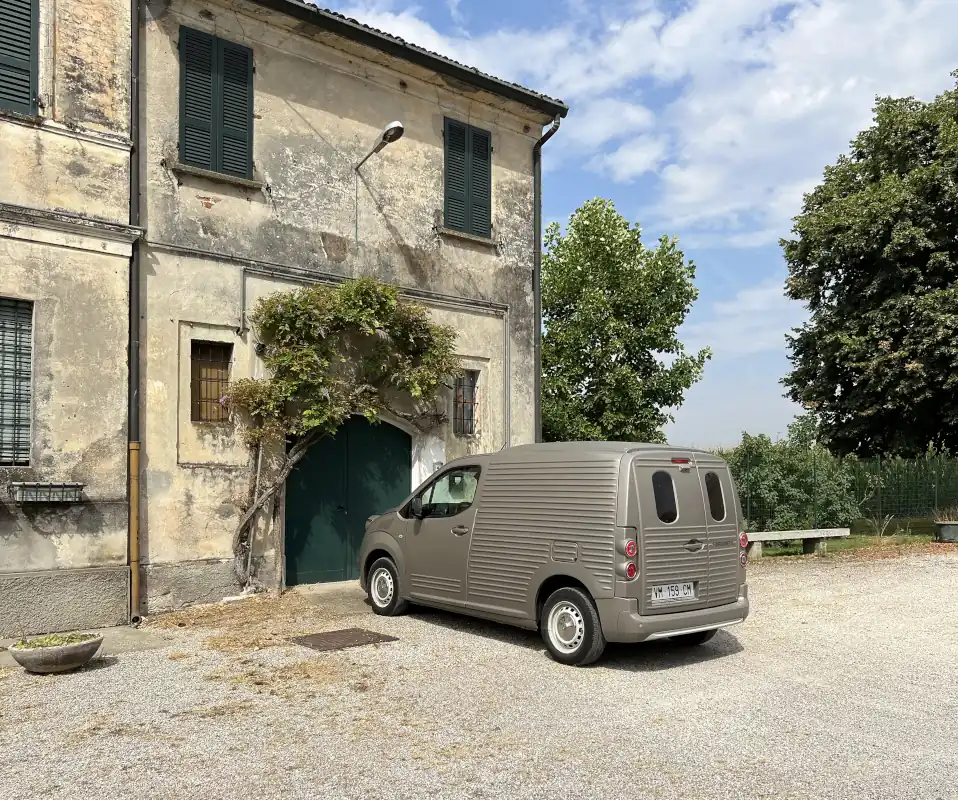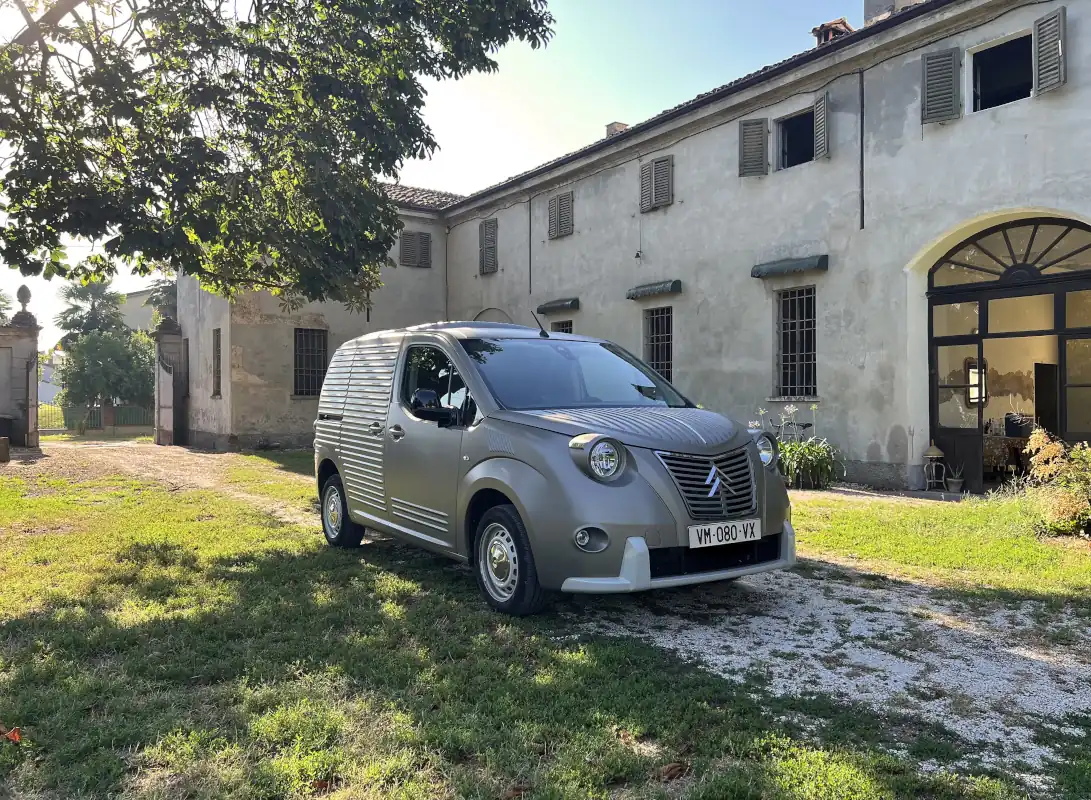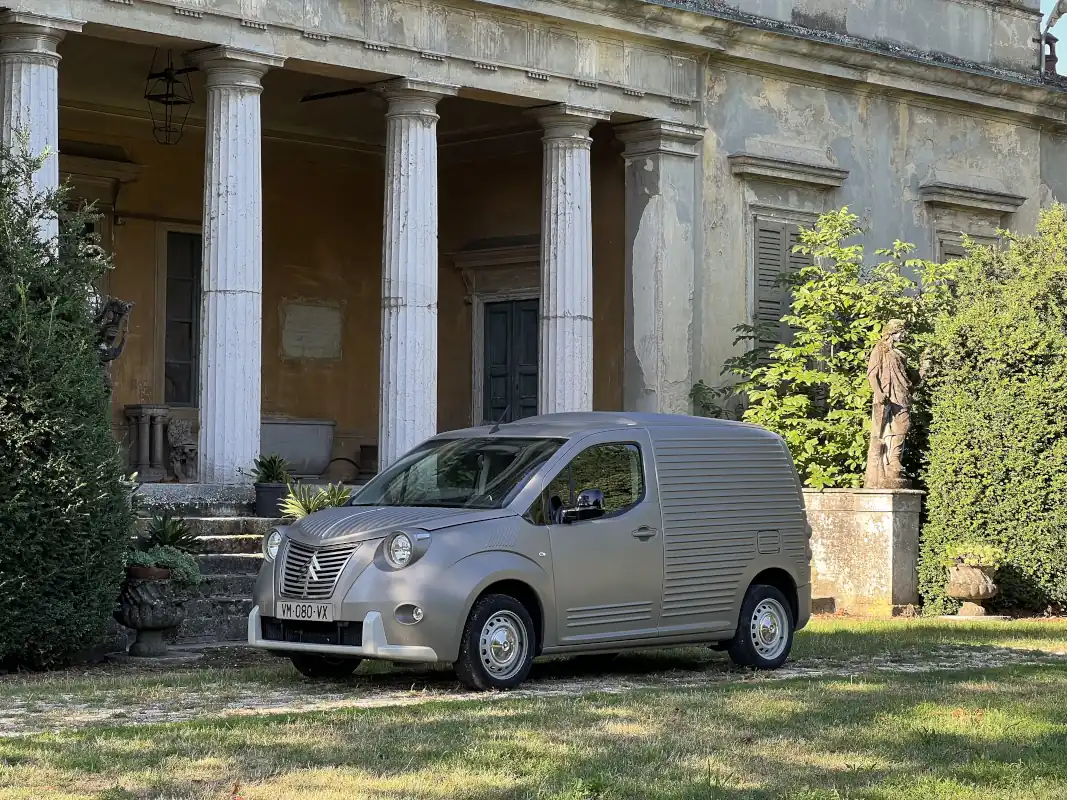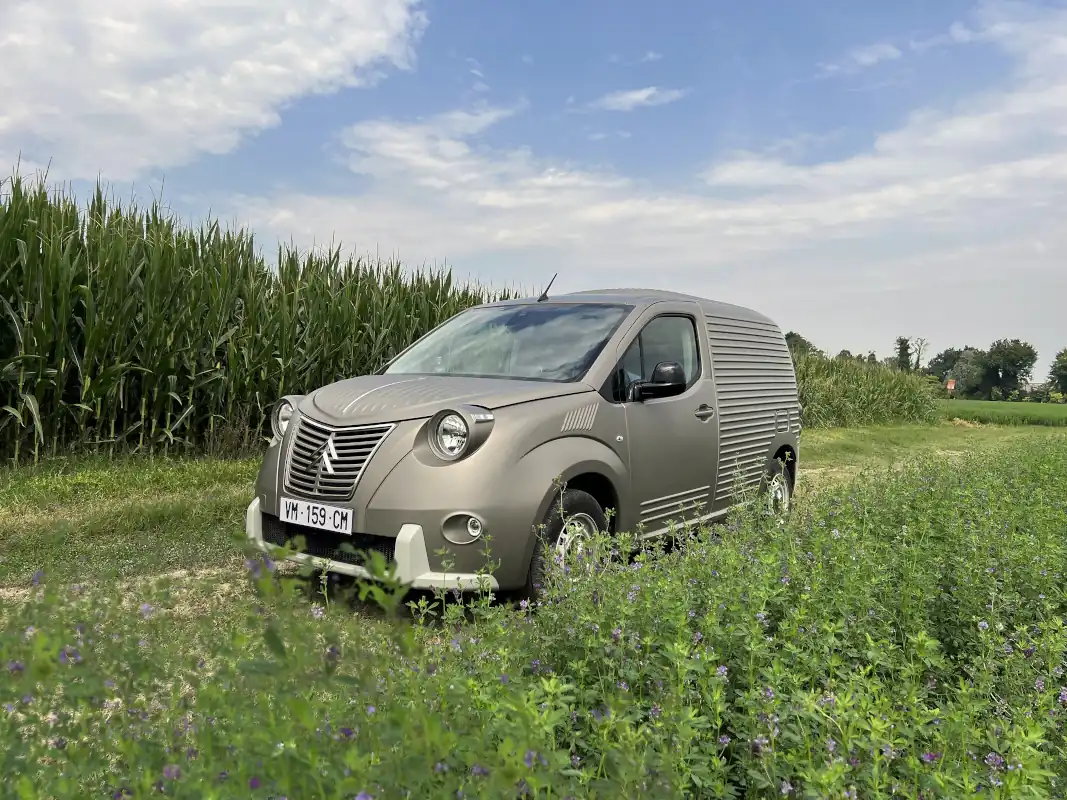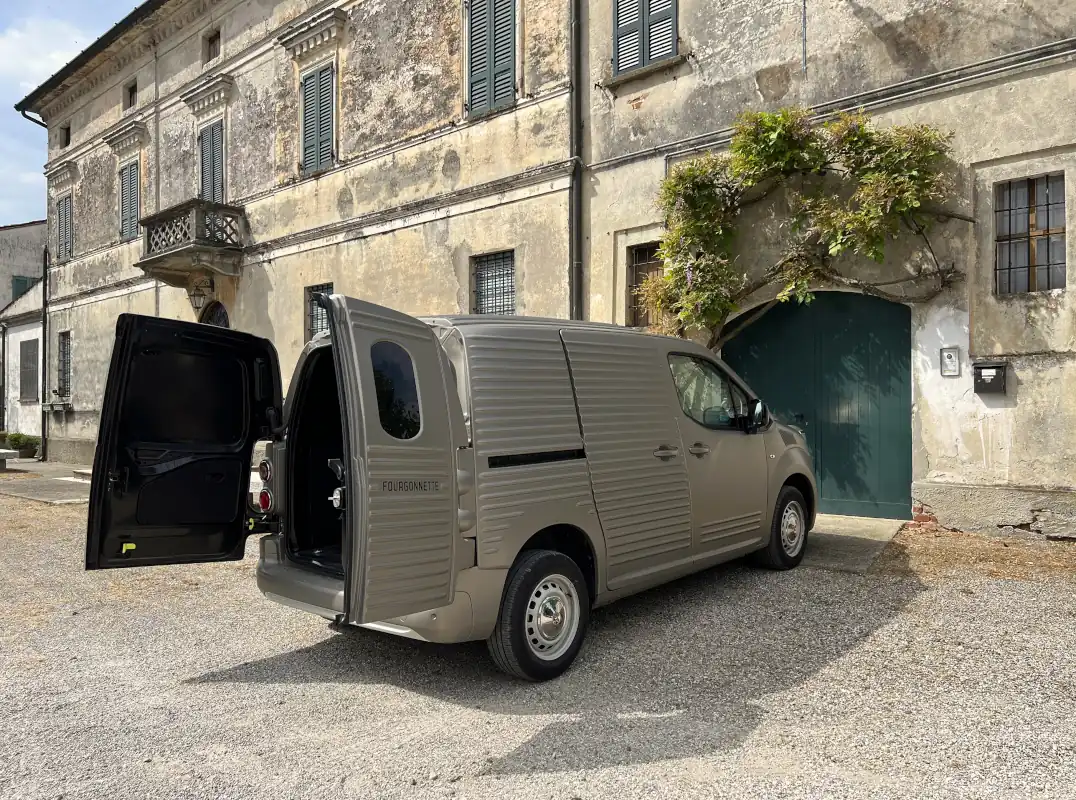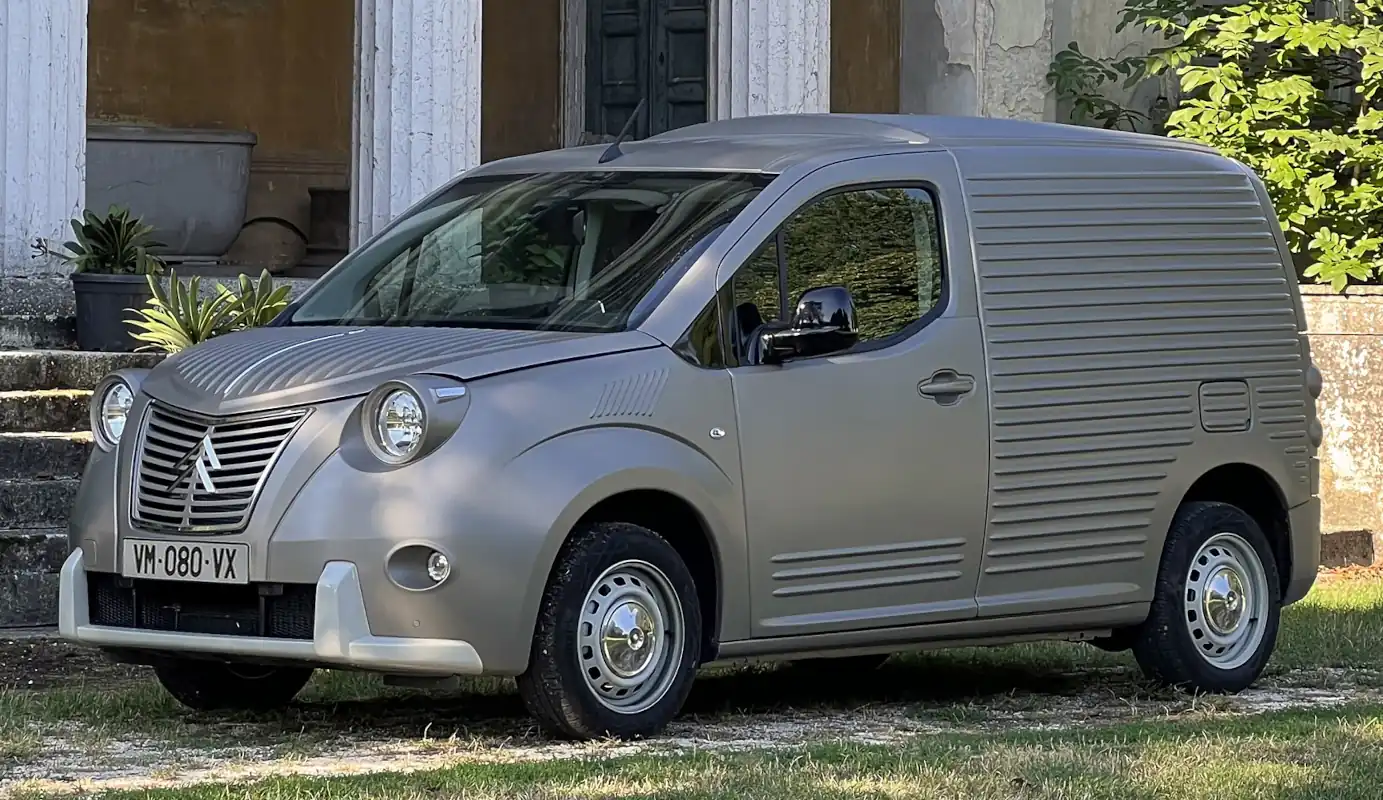
Citroën Berlingo features a number of exterior style components that pay homage to the legendary 2CV Fourgonnette AU (U for “Utility”) launched in 1951 which enjoyed a loyal following with its many spin-offs until 1987. The 2CV Berlingo Fourgonnette is a modern reinterpretation of it – one which has all the assets associated with the current Berlingo as far as architecture, loading capacities, modularity, on-board technologies and road performance are concerned.
“We are extremely proud that our best-selling Berlingo has been revisited by Caselani, drawing inspiration from the iconic 2 C V Fourgonnette, which left its mark on both Citroën’s history and that of the automotive sector more widely. Work on designing it got underway in the coachbuilder’s studios. We then worked together, hand-in-hand. Our own designers kept a close eye on work to ensure that the original 2CV Fourgonnette was not too literally interpreted, but that the result truly had Citroën’s DNA in it. Digital tools with which we are accustomed to working were used to treat the surfaces and scale the volumes, giving the vehicle a modern flavour”, said Pierre Leclercq, Head of Citroën Style.
1. A JOURNEY THROUGH TIME FOR CITROËN BERLINGO
Caselani has harnessed the wave of the vintage trend, which is well-established in the Italian car culture. This trend is apparent in both vehicles for individuals and professionals – it involves giving a new lease of life to a legendary model from the past, while incorporating all the modern equipment and high performance that you find on a current vehicle.
Concerning the specific case of the conversion performed on Berlingo, it is a reinterpretation that draws on the success of a pioneering van and the success of Berlingo Van itself, a major player on its segment in Europe since its launch in 1996, all three generations of which have sold more than 1 891 196 units. As of the end of August 2022, it was the second most successful vehicle in its segment in Europe, with a 17% market share. A highly versatile vehicle that has succeeded in reinventing itself over the years and a trailblazer in the leisure vehicle segment, it has introduced numerous innovations, including the integrated cabin, the three-front-seats configuration, the electric parking brake and more recently on the third generation, the overload indicator. It was also one of the first electric vans when it was launched in 2013.
Caselani entrusted this restyling exercise for Berlingo to David Obendorfer, renowned for having previously styled the Type H based on Citroën Jumper in 2017 and the new Type HG for Jumpy/SpaceTourer in 2020. This completes Citroën’s range of Caselani-designed vans.
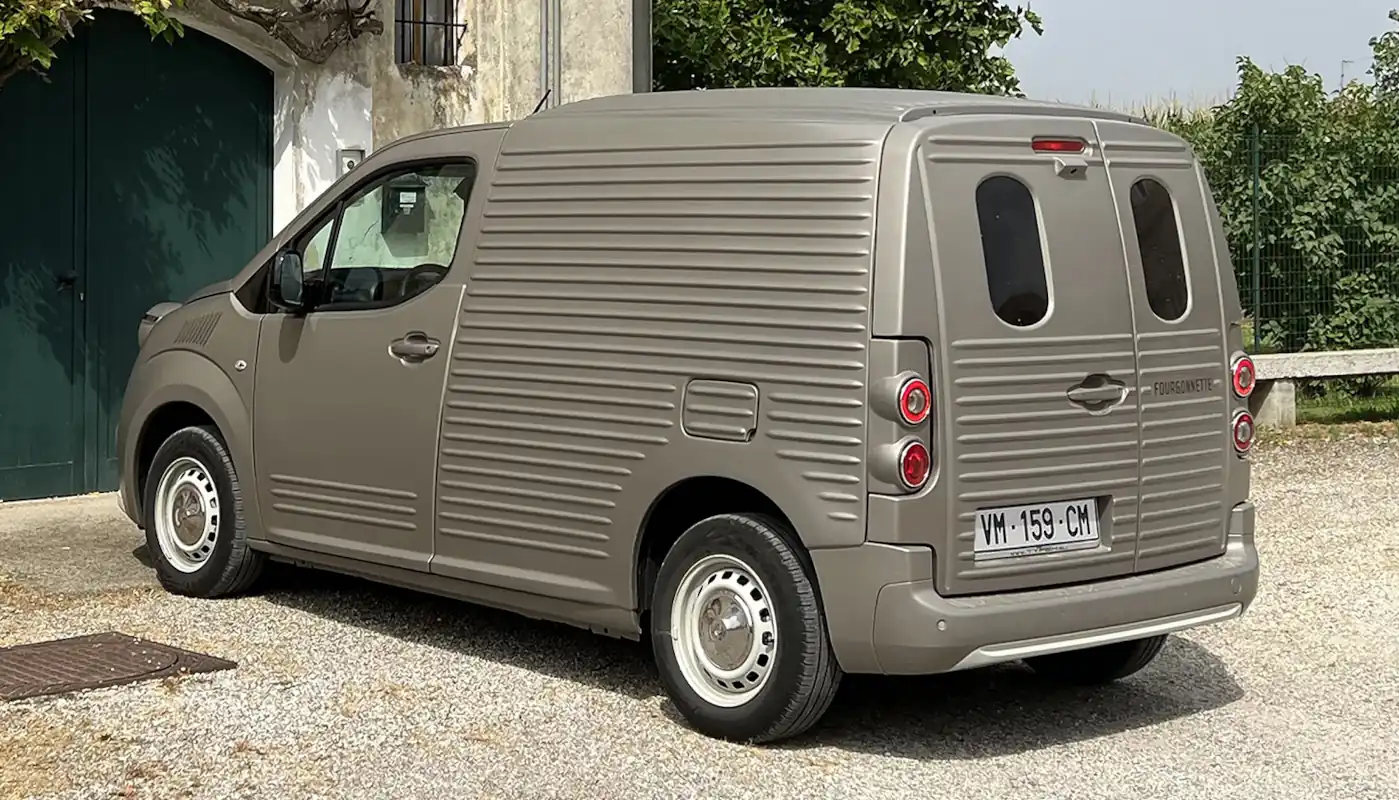
“The design specifications did not involve simply copying the forms of the old van in the strictest sense. Instead, they involved going back in time and bringing its unique charm to 21st-century vehicle. As a distant descendant, Berlingo was completely designed as a tribute to the Citroën 2CV of the 1950s. It was an exciting challenge because the original van had completely different proportions. It had very short front overhang, nice long bonnet and visually stand-alone load compartment, very different features from those of Berlingo. So I focused more on an overall evocative aspect of the original vehicle rather than straining the individual design elements to make them look like the 2CV Fourgonnette.”, explains Caselani designer David Obendorfer.
CHARACTERISTIC STYLE ELEMENTS FOR A NEO-RETRO PERSONALITY
The Berlingo 2CV Fourgonnette is a modern “lifestyle” representation, drawing inspiration from the legendary 2CV AU (“U” for “utility”) launched in 1951 – which proved hugely successful in its time with nearly 1,247,000 units sold – and its descendant, the 2CV AZU launched in 1954. The timeless codes of the original van have not been forgotten:
- Berlingo’s front end panel has been completely overhauled, revealing the features that were so characteristic of the old 2CV from days gone by. The grille, bumper and wheel arches have been replaced by new fibreglass components adapted to the frame, which integrates clips and bolts for attaching them. All of these components are assembled at Caselani’s workshops in Lombardy, Northern Italy.
- The V-shaped domed bonnet narrows towards the lower section – it “pinches”, to use the designer’s own jargon – just like before. The famous embossed striated coat sit in the centre of the front-end panel, extending over almost the whole of it.
- The round headlights are partly detached from the bonnet, fitting into it as they extend back – unlike the original ones which were completely offset. A more modern interpretation with components which fit in with the rest of the vehicle.
- The low-relief grooves at the top of the wheel arches featured on the old 2CV and were used to ventilate the engine.
- With its concave-cut upper section (or M-shaped, flared towards the top), the grille is attractive and distinctly Citroën, emblematic of the 2CV AU. The large chrome-plated chevrons – the brand’s signature – are highlighted, positioned right in the centre of the grille and overlaid on it, further emphasising them. All of these components are what has shaped the van’s identity, connecting it to Citroën’s history and reputation. The imposing grille is highly arched, integrated into the front end, and forming one with the bonnet as at the time. It extends downwards from the bonnet, giving one the impression that the wheel arches are floating – fitting into this key component. The line above the fog lamps, which stretches over the vehicle’s full width, further amplifies this effect. It gives stability to the front face and widens it, reinforcing its robust character.
- Visually, the front bumper is lower than on Berlingo. While the 2CV’s bumper was chrome-plated, this one is painted white, contrasting with the body. This emphasises the protective nature of the component, while at the same time investing it with a certain modernity.
-
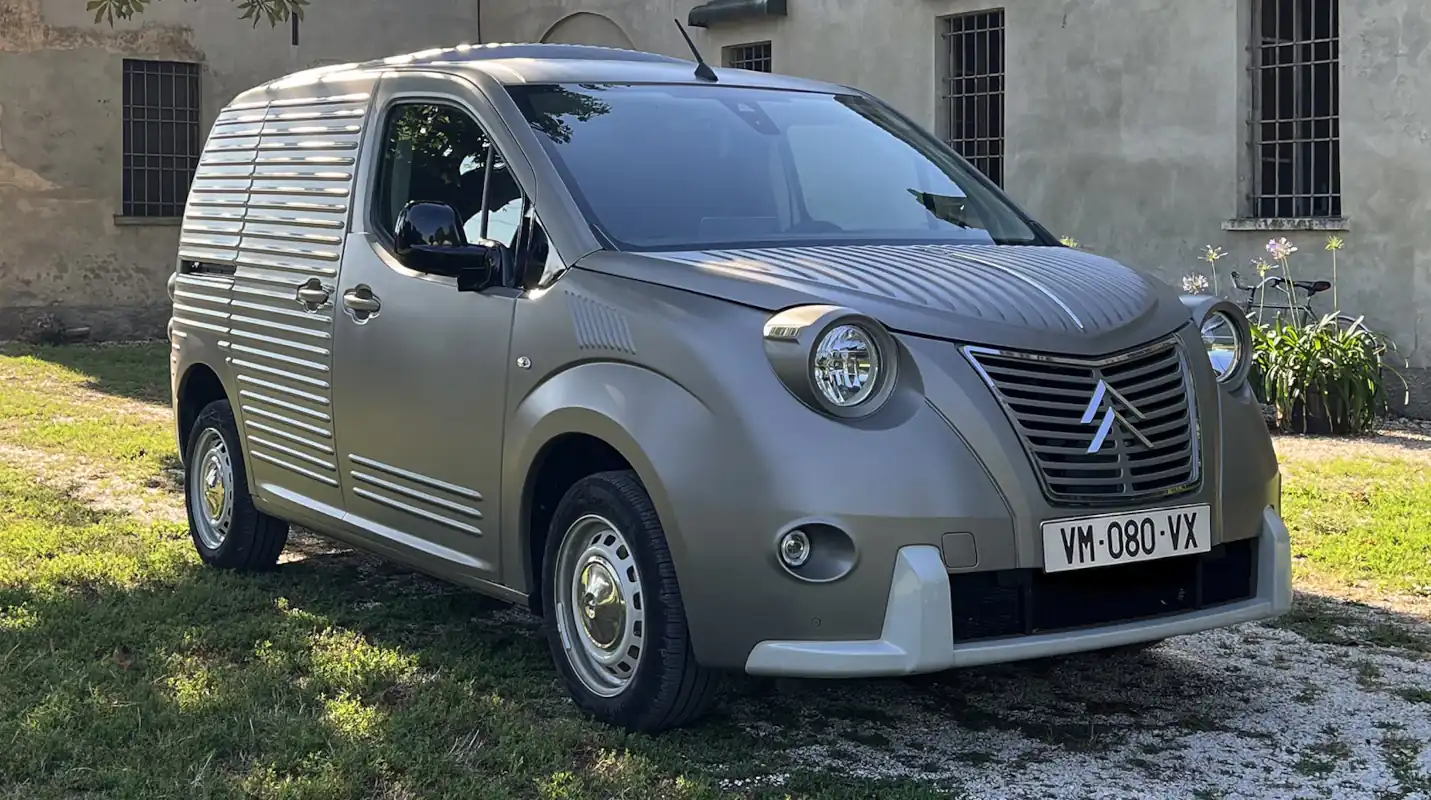
- The sides, rear doors and roof have all been given a second skin, topping off Berlingo’s bodywork. These fibreglass components all pay homage to the 2CV’s highly distinctive corrugated sheeting. But on this vehicle, they are purely decorative. Originally, they had an actual purpose – they were what gave the whole structure its rigidity. These striated components and the reworked – raised – roof – are a deliberate attempt to create a style whereby the vehicle’s passenger compartment section is separated from its cargo section. This was already a feature of the old van.
- At the rear of the vehicle, a small vertical window that is rounded at the top and bottom features on each of Berlingo’s rear doors – a further tribute to the 2CV. For a more modern feel, the very thick black seal around the windows has been removed. As for the vehicle’s stop and reversing lights, their perfectly round shape is brought to the attention by their sheer size. They are surrounded by red trim, making them even more visible and giving them a more contemporary feel.
- Various key locations on the vehicle are chrome-plated – another nod to the details that the 2CV sported. This applies to the headlights, the bonnet’s central ridge, the grille with its chevrons and contour trim, the original hubcaps (which are still manufactured to date) and the chrome-plated handles on the headlights which were used to open them (for replacing the bulbs). Only the handle for opening the bonnet has not been included in this new version.
2. ALL THE ADVANTAGES OF A MODERN VEHICLE
At the time, the 2CV Fourgonnette caused upheaval on its segment because of what it looked like and how it performed. The commercial van could reach average speeds of between 40 and 50 km/h and carry up to 250 kg of goods (as well as the driver) in an effective volume of 1.88 m³.
The new version has done away with all the noise of the two-cylinder engine and the hole in the grille for the crank. Needless to say, the Berlingo 2CV Fourgonnette brings with it the best of its era in terms of comfort, space, modularity and safety.
Berlingo Van can carry 3 people (5 in the private passenger version) and it can go significantly faster. It is also bigger – its loading capacity has quadrupled: (it can now carry up to a tonne) and its effective volume has practically tripled (it’s now 4.4 m³).
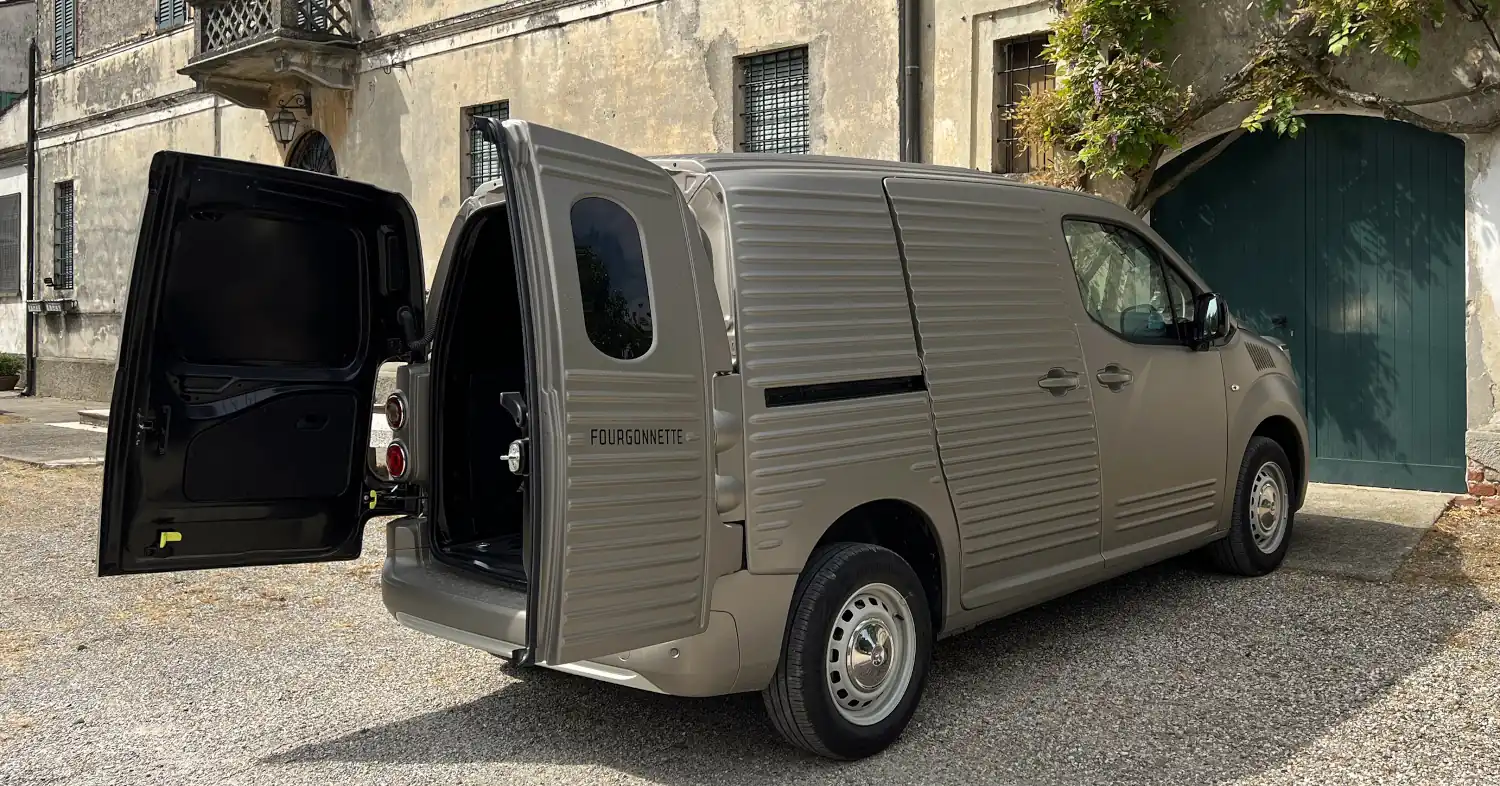
Despite being compact – which makes it agile and easy to handle – it still boasts plenty space aboard, making this utility vehicle the ideal tool for traders and craftsmen. Thanks to its Extenso® cabin, the vehicle’s effective length can be extended to up to 3.09 m (size M) by retracting the passenger seat.
To make driving, loading and performing manoeuvres easier, Berlingo Van features up to 18 driver assistance technologies and 4 connectivity technologies. These include the colour head-up display, hands-free access and start, the overload indicator and surround rear vision, as well as the Active Safety Brake, towing stability control, Grip Control with Hill Assist Descent and the blind angle monitoring system.
The commercial vehicle is available as a diesel-powered 1.5 BlueHDi, a petrol-powered 1.2 PureTech and an EAT8 automatic gearbox. The electric version has a range of up to 275 km per day, delivering a noise-free and vibration-free ride. It has the same effective volume and its battery can be charged to 80% in 30 minutes at a public charging station. ë-Berlingo Van has a deferred charging function and the temperature of the passenger compartment can be preset.
3. A CITROËN BERLINGO 2CV FOURGONNETTE WHICH ROUNDS OFF THE TYPE H RANGE
In 2017, to celebrate the 70th birthday of the Type H (500,000 of which were sold between 1948 and 1981), the coachbuilder developed a bodywork kit based on the Citroën Jumper. Then in 2020, he turned his attention to the Jumpy/SpaceTourer.
As far as the aesthetic transformation is concerned, the technique is same for all three Citroën vans. At the front, bodywork components (bonnet, bumper and wheel arches) are replaced by fibreglass. The side, rear and roof sections are covered with panels bonded directly to the bodywork. Round headlights are used instead of the ones which feature on current utility vehicles to perfect the vintage look and imbue them with all the powerful personality of the Type H or the 2CV Fourgonnette.
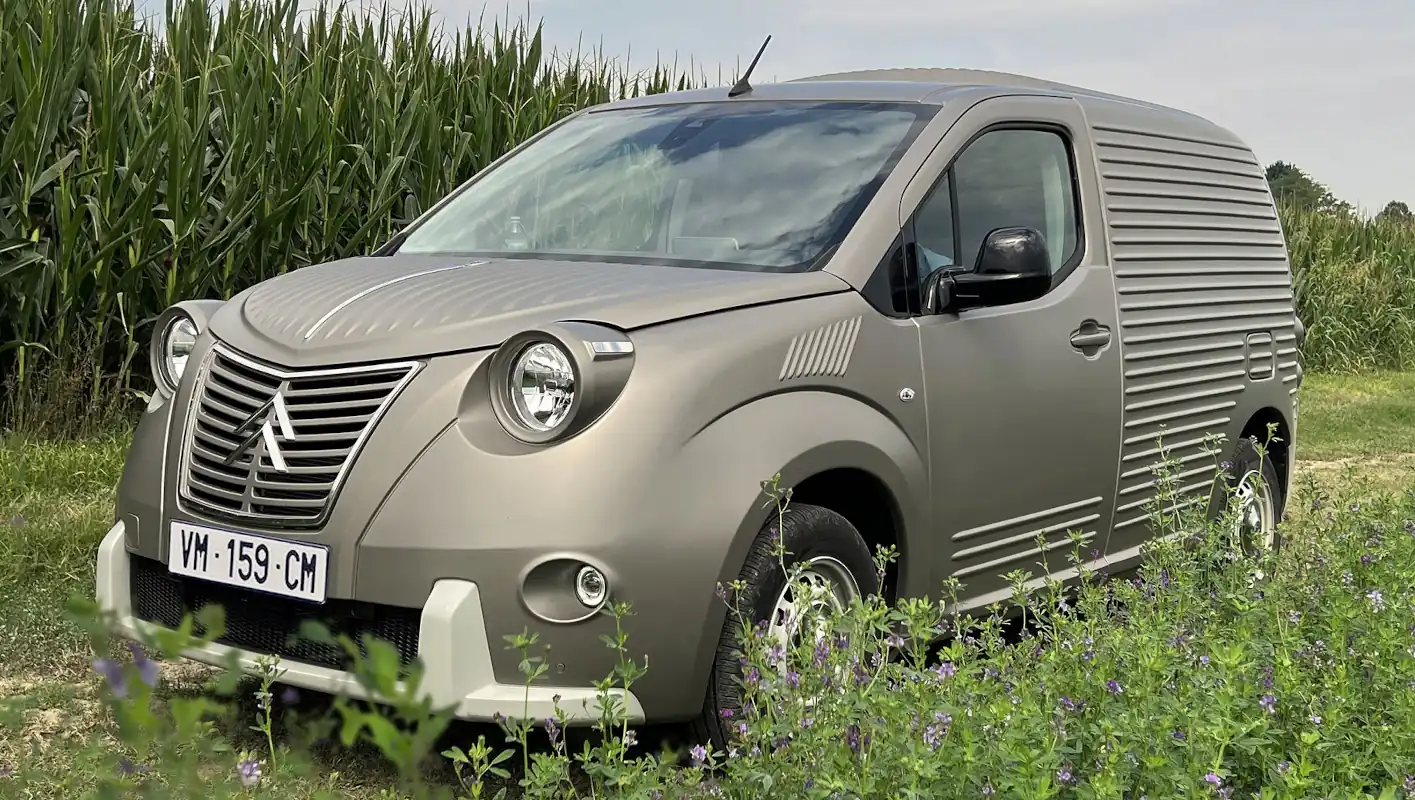
The Type H kit is compatible with all Jumper body types (L1 4.96 / L2 4.95 / L3 5.99 / L4 6.30) and the HG kit is available for all Jumpy /SpaceTourer sizes (XS 4.60 m / M 4.95 / XL 5.30). Versions are also available for the bases of converted vans in the Citroën catalogue, such as panelled vans, vans with windows, chassis-cabs, platform cabs, adapted vans, campervans, minibuses, food trucks, etc.
Transforming Jumper into a Type H proved a real challenge. Citroën’s largest van is not actually rectangular in shape, and it has its own specific design with numerous lines, some of which are overlaid over the panels. The kit has been developed to be perfectly fitted on the body of Jumper creating a robust union between the metal structure of the base vehicle and the fibreglass panels. A monoblock design component was created and integrated for the front of the vehicle. The front and bonnet are modelled together to make it easier to assemble and solidify the surface. Considerable technical prowess, which gives the Berlingo 2CV Fourgonnette a determined and robust air.
“As a diehard fan of the 2CV and the HY van, I have a whole collection of old Citroën models. My wife is as much of an enthusiast as I am – she travelled through Europe in the 2000s in a Type H converted into a campervan. When my family started getting bigger, the idea to create a more spacious and comfortable HY came to us: why not take the Jumper’s current architecture and attach fibreglass panels to its bodywork? Then everything fell into place… A prototype was presented to Citroën’s Design teams who were won over by the idea. Production got underway in 2017 and was then expanded to include its little brother in 2020. The only thing missing to complete our range of Citroën commercial vehicles was Berlingo. Today, the van presents its 2CV Fourgonnette kit, the design of which is the result of the joint efforts of both Caselani’s teams and those of Citroën. We are delighted to see the friendly face of this legendary van again which made its mark on the 1950s”, says Fabrizio Caselani, Director of Carrosserie Caselani.
